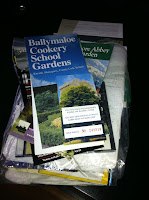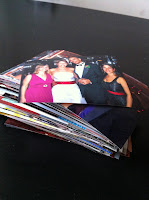 I recently read an article on digital hoarding. It was definitely eye opening and it made me realize that I am actually an email hoarder. I have thousands of emails still sitting in my three in-boxes. I haven't deleted them because whenever I go to do so, I stop myself, thinking I may need something in them down the road. This is really not a good strategy. Chances are I won't need anything in these emails and if I do, most likely I can find it on Google or ask for it to be re-sent.
I recently read an article on digital hoarding. It was definitely eye opening and it made me realize that I am actually an email hoarder. I have thousands of emails still sitting in my three in-boxes. I haven't deleted them because whenever I go to do so, I stop myself, thinking I may need something in them down the road. This is really not a good strategy. Chances are I won't need anything in these emails and if I do, most likely I can find it on Google or ask for it to be re-sent. I have a much easier time with photos. Maybe it's because I've been in the industry for many years. There are lots of photos we take that we really don't need. With digital, we can take 100 pictures of the beautiful sunset on our Hawaiian vacation. But really we could probably do with one or two of those, and delete the rest. Those other 98 are taking up space on your hard drive, cluttering your computer, and slowing your computer down. Not only that, it slows you down too, because the more pictures you have, the more time it takes to find the one you need! Multiply this by the extra pictures taken at your child's soccer game, family events, and everyday moments, and this can add up to a lot of extra photos clogging your computer! When you download your pictures, do you go back and delete the photos you don't need? Most people don't.
 I actually go through the deleting process a second time in a lot of cases. When I download my pictures (and I try to do it as soon as possible after the event), I go through and delete the ones I don't need immediately. By doing this, it's a quick and easy job versus something that becomes more overwhelming the more you let it pile up. But I also take a lot of pictures that I share. I don't need all those pictures, but I take them because I know how much other people appreciate them. I upload them to a photosharing app and cloud storage app called Linea, and share them with the others from the event. If anyone else at the event was taking pictures, they can also upload them to the same "Line" of photos, allowing everyone that was at the event to view all the photos in ONE place, add comments and captions, and export any of the photos they want back to their own computer in the same resolution that they were uploaded in. Linea is a free app, and it works on PC and Mac, iPad, iPhone and Android. I like this because everyone in my family uses something different. Its also private and secure. The only people that can see your photos are the ones you shared them with. If, like me, you have a lot of photos to store, you may want to consider a subscription for unlimited cloud storage. There are lots of other sites you can use to store your photos such as Dropbox, Carbonite, Flickr, Picasa, and more but I personally like the viewing mosaic and other features of Linea that I mentioned above. But for the record, I am a Dropbox and SmugMug user too.
I actually go through the deleting process a second time in a lot of cases. When I download my pictures (and I try to do it as soon as possible after the event), I go through and delete the ones I don't need immediately. By doing this, it's a quick and easy job versus something that becomes more overwhelming the more you let it pile up. But I also take a lot of pictures that I share. I don't need all those pictures, but I take them because I know how much other people appreciate them. I upload them to a photosharing app and cloud storage app called Linea, and share them with the others from the event. If anyone else at the event was taking pictures, they can also upload them to the same "Line" of photos, allowing everyone that was at the event to view all the photos in ONE place, add comments and captions, and export any of the photos they want back to their own computer in the same resolution that they were uploaded in. Linea is a free app, and it works on PC and Mac, iPad, iPhone and Android. I like this because everyone in my family uses something different. Its also private and secure. The only people that can see your photos are the ones you shared them with. If, like me, you have a lot of photos to store, you may want to consider a subscription for unlimited cloud storage. There are lots of other sites you can use to store your photos such as Dropbox, Carbonite, Flickr, Picasa, and more but I personally like the viewing mosaic and other features of Linea that I mentioned above. But for the record, I am a Dropbox and SmugMug user too. Once I've uploaded to Linea, sometimes I go back and delete other pictures I know I won't need. For example, I take a lot of pictures for my kids' sports teams. At a game, I might take hundreds of pictures. Ultimately, I don't need all those pictures. I really only need and want the ones of my own children. So I go back and delete the others from my computer after the season is over and I've shared the photos.
My backup system consists of cloud storage for my photos, and an external hard drive for all of my files. My photos are the one thing on my computer I'd be devastated about if I lost, so they're backed up in several different ways. One thing to note when you are backing up everything to the cloud, make sure your photos are being backed up in full resolution. In the last few weeks during my photo organizing seminars, twice I have run into people who have used cloud storage companies to back up their entire computer. Unfortunately these two people had their computers crash and had to rely on the cloud storage company to retrieve their data. In these particular cases, their photo files came back as thumbnails. They weren't saved in the original resolution and so for all intensive purposes, these folks lost their photos, because you really can't do much with thumbnails. Needless to say, they were devastated. So, do your research when choosing a cloud storage option. But, cloud storage should be part of your backup plan, regardless of who you use.
If you want to read more about digital hoarding, check out this article from the Wall Street Journal. As for me, I think I am going to go clean out one of my in-boxes. Maybe I will find it easier if I do it one in-box at a time! What about you? Are you a digital hoarder?




